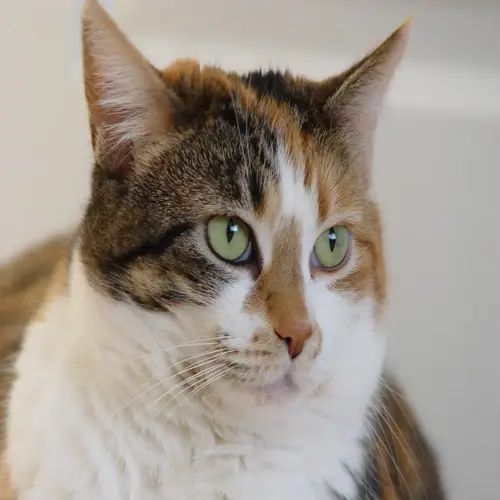Cat Vertical Space Solutions for Happy Felines

Written by
David Smith
Reviewed by
Prof. David Walsh, Ph.D.Vertical space for cats meets their inherently instinctual climbing tendencies and reduces territorial stress
Window perches allow for some mental stimulation via outdoor views
The shelving pathways allow for safe highways and eliminates conflict at ground level
Cat trees provide the foundational vertical territory coupled with scratching surfaces
Having multiple elevated areas reduces resource guarding in a multi-cat household
DIY solutions that improve vertical access are often cost effective, making these ideas achievable anywhere
Article Navigation
Your cat's desire for cat vertical space comes from its wild ancestors, who climbed trees for safety and hunting. Indoor cats carry inherited instincts, but their territory is limited. Giving your cat vertical choices satisfies his inborn instincts.
While outdoor cats patrol territories several acres in extent, indoor cats have only a few hundred feet of territory. This vastly different area leads to stress and a sense of boredom. Vertical solutions add flexibility to the territory by creating usable areas without requiring additional floorspace.
Raised areas provide three vital advantages. They serve as safe observation points that alleviate anxiety. They increase surface area for confident movement. They encourage physical exercise when climbing. These solutions turn a cramped apartment into a cat's paradise.
Window Perches: Maximizing Views
Selecting between a suction cup and a permanent window perch depends on your circumstances. A temporary perch, such as the suction cups, offers the renter the advantage of being non-destructive to walls and window frames and easily removed. The homeowner might have the benefit of having a perch fully secured (as in nailed into the window frames). Still, it definitely offers a more permanent solution. Either option presents a good opportunity for outside viewing.
Set a bird feeder outside your cat's window seat. It turns the area into a natural TV station. Your cat gets mental activity as he watches the birds and squirrels. Watching wildlife is a nice diversion and satisfies his hunting instincts while still being indoors and safe.
Check perching weight limits carefully before installation. Most models support cats under 15 pounds or 7 kilograms. Heavy-duty models support even 25-pound or 11-kilogram cats. Exceeding limits can lead to falls and injuries.
Before mounting any perch, verify the compatibility of tempered glass by applying suction cups to a small area for 48 hours. Then, check for bubbles or movement. For built-in perches, have them installed by a professional, as improper installation may compromise window seals.
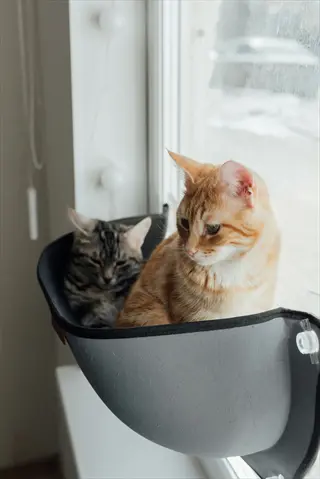
Suction-Cup Perches
- Rental-friendly design: Requires absolutely no permanent installation or wall damage for temporary setups in apartments.
- Weight capacity: Securely supports cats up to 25 pounds (11.3 kilograms) when properly attached to clean glass surfaces.
- View enhancement: Strategic positioning facing trees or bird feeders stimulates natural hunting instincts throughout the day.
- Safety tip: Check suction strength every seven days and avoid direct sunlight to prevent adhesive weakening problems.
- Installation ease: Most models attach quickly in under five minutes with simple lever-activated suction mechanisms.
- Maintenance: Many feature machine-washable cushions with removable fabric components for regular hygiene upkeep.
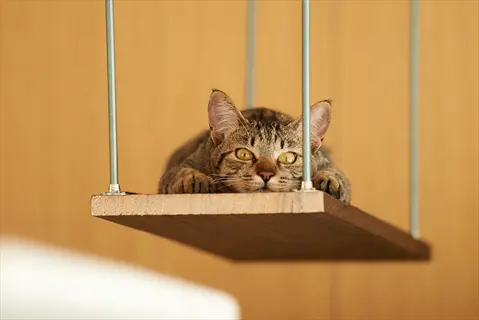
Built-In Shelves
- Permanent solution: Anchored directly to wall studs providing maximum stability for long-term cat usage reliability.
- Customization options: Available in various depths from 12 to 24 inches (30-60 centimeters) to accommodate different cat sizes.
- Sun exposure: Perfect for south-facing windows where cats can bask comfortably in warm sunlight during winter.
- Material safety: Use only untreated hardwoods to avoid toxic varnishes that cats might accidentally chew.
- View optimization: Elevate 4-5 feet (1.2-1.5 meters) above ground level for ideal bird-watching height positioning.
- Added feature: Many include side rails providing extra balance support for senior cats during entry.
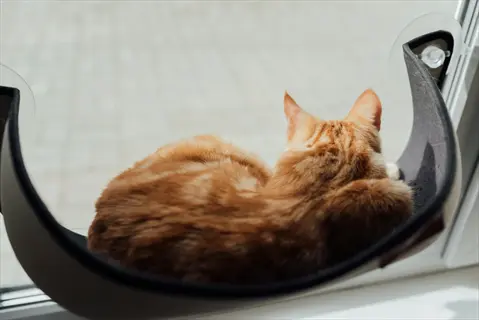
Hammock Styles
- Comfort focus: Fabric designs distribute feline weight evenly for relaxed lounging during extended nap sessions.
- Space efficiency: Suspended models occupy minimal visual space while maximizing vertical territory usage potential.
- Weight limits: Typically support 15-20 pounds (6.8-9 kilograms) depending on fabric tension and frame construction strength.
- Temperature note: Mesh materials provide significant airflow advantages during warmer summer months for cooling.
- Versatility: Most feature adjustable straps allowing height customization between 3-6 feet (0.9-1.8 meters).
- Cleaning: Nearly all hammock covers detach easily for convenient machine washing to maintain cleanliness.
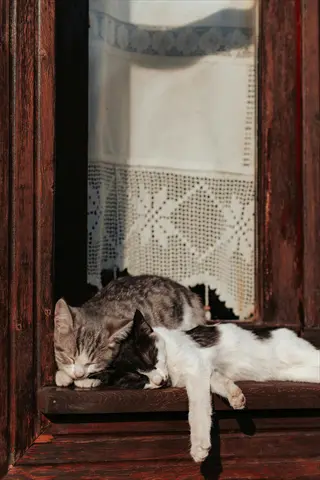
Frame-Mounted Perches
- Structural design: Clamps securely onto window frames without requiring screws or permanent wall modifications.
- Adjustability: Accommodates various window frame thicknesses from 1-3 inches (2.5-7.6 centimeters) with tension knobs.
- Sturdiness: Supports cats up to 30 pounds (13.6 kilograms) due to direct pressure distribution along frames.
- View preservation: Maintains full window visibility without obstructing views through clever mounting techniques.
- Installation tip: Requires measuring frame depth precisely before purchasing to ensure proper fit compatibility.
- Maintenance: Wipe clean with damp cloth weekly to prevent dust accumulation around mounting mechanisms.

Corner Perches
- Space utilization: Specifically designed to fit snugly into window corners maximizing unused triangular spaces.
- Stability advantage: Triangular shape provides three-point anchoring making them exceptionally sturdy platforms.
- Multi-cat feature: Larger models accommodate two cats simultaneously without compromising safety or comfort.
- View angles: Angled positioning gives cats panoramic views both indoors and outdoors simultaneously.
- Measurement requirement: Requires precise corner angle measurement (usually 90 degrees) before installation.
- Material options: Available in plastic, wood, or cushioned fabrics depending on durability and comfort needs.
Shelves: Building Cat Highways
Correct spacing of shelves is crucial for the well-being and safety of your cat. The separation of shelves (both horizontal and vertical) should be no more than twelve to fifteen inches. This corresponds to the normal jumping range of most cats and will help avoid strain and falls, encouraging a more confident feeling when they move along these routes.
Select safe materials for your cat shelves. Untreated hardwoods such as birch or maple are best. For finishes, avoid toxic materials and softwoods that splinter. Use steel L brackets rated strong enough to hold at least 1.5 times the weight of your heaviest cat. Be sure to secure everything to the wall studs.
Establish flowing routes that connect distinct vertical areas. Create routes between key locations, such as window seats and feeding areas. Intermediate stepping shelves must be provided where there are more than 15 inches between routes. Wider rest platforms are required periodically to allow for comfortable halts.
Maximize small areas with smart ideas. Corner shelves go snug in unused angles. Over-door perches utilize dead airspace without occupying floor space. Zig-zag patterns permit vertical travel in narrow spaces. These approaches triple the usable territory in cramped rooms.

Basic Perch Shelves
- Resting function: Provide spacious 12x18 inch (30x45 cm) platforms where cats can comfortably lounge for hours while observing their territory below.
- Placement height: Install between 4-6 feet (1.2-1.8 meters) above ground level to satisfy cats' natural preference for elevated vantage points.
- Material safety: Always select untreated birch or maple woods that completely avoid toxic finishes which curious cats might chew during exploration.
- Weight capacity: Ensure proper wall anchors are used to reliably support cats up to 25 pounds (11.3 kilograms) without stability concerns.
- Corner advantage: Triangular designs efficiently maximize unused corner space while offering enhanced stability through contact with adjacent walls.
- Entry/exit planning: Strategically position near existing furniture like bookshelves to create natural transition points within pathway networks.
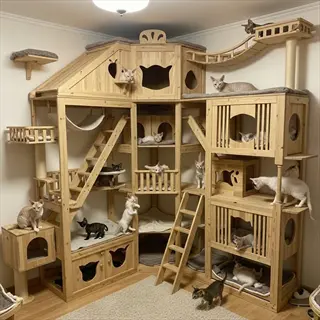
Stepped Pathway Shelves
- Jump sequencing: Maintain consistent 12-15 inch (30-38 cm) spacing both horizontally and vertically between shelves to accommodate safe feline leaps.
- Corner solutions: Incorporate specially angled connectors that allow seamless 90-degree turns without disrupting jumping momentum or confidence.
- Material durability: Utilize sturdy ¾ inch (1.9 cm) plywood covered with carpet for optimal traction and long-lasting performance over years.
- Weight distribution: Reinforce all joints with durable metal brackets when housing multiple cats or larger breeds exceeding 20 pounds (9 kilograms).
- Path creation: Design continuous routes stretching from floor-level starting points to ceiling-high perches across interconnected rooms.
- Small-space hack: Implement compact zigzag patterns that maximize vertical travel efficiency within narrow corridors or underutilized alcoves.

Combined Rest/Scratch Shelves
- Dual function: Seamlessly integrate sisal scratching surfaces into shelf undersides or vertical supports to serve multiple feline needs simultaneously.
- Placement strategy: Install near room entryways where cats instinctively mark territorial boundaries through regular scratching behavior.
- Material safety: Choose natural sisal fibers without synthetic adhesives that might contain potentially harmful chemical compounds for cats.
- Size specifications: Provide minimum 16x20 inch (40x50 cm) platforms allowing full-body stretching during scratching sessions for comfort.
- Noise reduction: Apply felt padding beneath shelves to absorb vibrations and prevent wall noise during energetic scratching activities.
- Replacement plan: Design removable sisal panels allowing easy replacement every 6-12 months when surfaces show significant wear.

Over-Door Perches
- Space efficiency: Effectively utilize frequently overlooked airspace above door frames without requiring permanent modifications or wall damage.
- Mounting system: Employ heavy-duty clamps capable of accommodating various door thicknesses ranging from 1.5-2 inches (3.8-5 cm).
- Weight limits: Ensure reinforced steel brackets properly support cats up to 18 pounds (8.1 kilograms) for secure daily usage.
- Safety rails: Include 3-inch (7.6 cm) raised edges preventing accidental falls when cats are sleepy or adjusting positions.
- Multi-room access: Create extensive highway networks using consecutive doors throughout living spaces for uninterrupted exploration.
- Rental-friendly: Offer completely reversible installation leaving zero damage when removed unlike traditional wall-anchored alternatives.

Cantilevered Corner Shelves
- Structural innovation: Feature triangular support systems transferring weight directly into wall studs at corner junctions for superior stability.
- Space maximization: Occupy typically wasted vertical corner space stretching continuously from floor to ceiling heights.
- Stability advantage: Three-wall contact points create exceptionally sturdy platforms capable of supporting energetic jumping routines.
- Custom sizing: Incorporate adjustable arms accommodating corner angles ranging from 90-120 degrees for flexible installation options.
- Weight capacity: Securely hold up to 35 pounds (15.9 kilograms) using industrial-grade mounting hardware suitable for large cats.
- Aesthetic bonus: Achieve modern floating appearance that complements home decor while providing essential feline functionality.
Planning Your Highway
- Path mapping: Carefully sketch potential routes connecting key areas like sunny windows, existing cat trees, and favorite resting zones.
- Jump measurement: Consistently maintain 12-15 inch (30-38 cm) gaps between shelves to accommodate safe feline leaping capabilities.
- Obstacle check: Meticulously avoid pathways crossing hazardous appliances like ceiling fans, heaters, or electronics.
- Stud location: Thoroughly scan walls using electronic stud finders to identify solid wood framing beneath drywall surfaces.
Material Preparation
- Wood selection: Choose durable ¾ inch (1.9 cm) plywood or solid wood boards providing reliable shelf bases for daily usage.
- Surface treatment: Carefully sand all edges smooth before applying non-toxic water-based sealants for long-lasting protection.
- Traction addition: Securely glue low-pile carpet remnants or sisal mats across surfaces to prevent potentially dangerous slipping incidents.
- Hardware check: Select industrial-grade brackets rated for 1.5x your heaviest cat's weight to ensure structural integrity.
Secure Mounting
- Stud anchoring: Always drill mounting hardware directly into wall studs rather than depending solely on drywall anchors for safety.
- Bracket placement: Position L-brackets every 16 inches (40 cm) along shelves exceeding 24 inches (60 cm) in length for optimal support.
- Level verification: Utilize bubble levels throughout installation to guarantee perfectly flat surfaces preventing balance issues.
- Weight test: Apply 1.5x expected load using sandbags for 24 hours before allowing cat access to confirm stability.
Pathway Optimization
- Transition planning: Add intermediate stepping shelves wherever vertical gaps exceed 15 inches (38 cm) to facilitate easier climbing.
- Corner solutions: Install specially designed angled connector shelves enabling smooth 90-degree turns within pathway systems.
- Rest integration: Incorporate wider 24x24 inch (60x60 cm) platforms every 4-5 steps for comfortable lounging during exploration.
- Safety rails: Attach protective 3-inch (7.6 cm) wooden borders around elevated perches to prevent accidental falls.
Maintenance Protocol
- Monthly inspection: Conduct thorough checks of bracket tightness and wood integrity every 30 days to ensure ongoing safety.
- Cleaning routine: Gently wipe surfaces weekly using damp cloths while completely avoiding harsh chemical cleaning products.
- Traction renewal: Replace carpet or sisal coverings every six months when surfaces exhibit noticeable wear or reduced grip.
- Load reassessment: Carefully re-evaluate weight limits whenever introducing additional cats to household environments.
Safe Installation Guidelines
Before letting your cat use any shelves, test them to ensure they meet the weight capacity. Place sandbags on the shelf, weighing 1.5 times heavier than the heaviest cat you're using, and leave them in place for 24 hours. Start with half the weight and gradually increase. Check for bent brackets or wall anchors pulling out.
Locate wall studs accurately for safe mounting. Use an electronic stud finder on drywall by sliding it horizontally across the surface. On plaster walls, tap gently and listen for solid, thudding sounds. For brick walls, use masonry anchors, rated for the weight capacity of your cat.
Keep shelves out of hazardous areas; store shelves at least 36 inches away from heating units or stoves. Leave 24 inches between shelves and electronic appliances and power cords. Leave 18 inches of space between the storage and the ceiling fans. This protects against burns, shocks, or injury while jumping.
To prevent falls from heights of more than four feet above the ground, construct safety railings at least three inches high along the edges of the area. Either carpets or sisal mats should be laid down on the floors to provide a secure footing. Ramps or similar escape routes should be located no further than eighteen inches from the high perches.
Weight Testing Protocol
- Load simulation: Place sandbags weighing 1.5x your heaviest cat's weight on shelves for 24-48 hours
- Progressive testing: Start with 50% load, increase gradually to full test weight over 6 hours
- Failure signs: Check for bracket bending, wall anchors pulling out, or shelf sagging exceeding ¼ inch (0.6 cm)
Wall Stud Location
- Finding studs: Use electronic stud finders calibrated for your wall type (drywall, plaster, or brick)
- Measurement standards: Studs typically spaced 16 inches (40 cm) apart in modern homes
- Verification: Confirm by drilling small pilot holes and checking wood resistance
Hardware Selection
- Bracket types: Use L-brackets with minimum 3-inch (7.6 cm) arms for shelves over 18 inches (45 cm)
- Screw specifications: 3-inch (7.6 cm) #10 screws for wood studs, toggle bolts for hollow walls
- Weight ratings: All hardware should support 1.5x expected maximum load
Fall Prevention
- Rail requirements: Install 3-inch (7.6 cm) high rails on perches over 4 feet (1.2 meters) high
- Traction surfaces: Apply sisal mats or low-pile carpet with non-toxic adhesives
- Clearance zones: Maintain 18-inch (45 cm) clearance from ceiling fans or light fixtures
Maintenance Schedule
- Weekly checks: Inspect bracket tightness and wood integrity every 7 days for first month
- Monthly inspections: Verify all mounting points and hardware stability ongoing
- Load reassessment: Retest weight capacity when adding new cats or heavier breeds
Cat Trees: Foundation of Vertical Design
Conventional designs of cat trees rely upon widely spaced bases to keep them from tipping over. Modern designs use triangular bracing for support. Heavier models have weighted bottoms for added security. Wall-mounted versions bolt into studs for maximum security, especially for high-climbing individuals and multi-cat families.
When considering your cat's safety, choose the materials for scratching posts wisely. Natural sisal rope lasts significantly longer than carpet when it comes to scratching. Solid hardwoods, such as birch, resist wobbling more than particle board. The washable fabrics simplify machine cleaning. Avoid toxic glues or finishes that are toxic to cats and can be chewed.
Perches must be made to be comfortable and secure. Raised edges must be at least three inches high on elevated surfaces. Resting areas must be large enough to allow for whole-body stretches. Construct partial walls or hoods on condos to create cozy hideouts desired by the cats.
Strategically position cat trees in multiple cat households. Seek a position away from high-traffic areas but near windows. Put multiple trees in various rooms. Positioned near existing vertical pathways, creating connected territory networks is possible.
Traditional Multi-Tier
- Structure: 4-6 platforms with vertical scratching posts and enclosed condos
- Stability: Requires wide base (minimum 24x24 inches/60x60 cm) for top-heavy designs
- Materials: Carpet-covered particleboard with sisal-wrapped posts
- Best for: Multi-cat households needing separate territories
- Placement tip: Position in corners to leverage wall support
Modern Minimalist
- Structure: Open platforms with wooden frames and removable cushions
- Stability: Solid wood construction with triangular bracing supports
- Materials: Birch or maple woods with machine-washable fabric
- Best for: Small spaces with aesthetic priorities
- Placement tip: Install near windows for visual enrichment
Space-Saving Wall-Mounted
- Structure: Modular shelves connected by bridges and ramps
- Stability: Direct stud mounting required for each component
- Materials: Plywood with non-toxic water-based finishes
- Best for: Apartments with limited floor space
- Placement tip: Create pathways between rooms
Premium Activity Centers
- Structure: Includes hammocks, dangling toys, and multiple perches
- Stability: Reinforced steel frames with weighted bases
- Materials: Combination of solid wood, sisal, and fleece
- Best for: Active kittens and young cats
- Placement tip: Center in playrooms away from obstacles
Outdoor/Patio Designs
- Structure: Weather-resistant materials with covered perches
- Stability: Concrete footings or ground anchors required
- Materials: Cedar wood with UV-resistant fabrics
- Best for: Enclosed patios or catios
- Placement tip: Provide shade and weather protection
Multi-Cat Home Strategies
In homes with multiple cats, it is advisable to follow the one perch for every cat plus one rule. This means that if you have three cats, you should have four perches. This avoids competition and allows for escape when things start to heat up.
Incorporate staggered feeding times to promote sharing of space by cats. Feed shy cats first on window perches and then, once they are confident, place them in the same areas of space after the shy cats. Move location daily. This will help create a positive association while preventing food guarding at the vertical stations.
Establish different routes for various personalities. Create high routes above five feet for bold cats using open ledges. Create low routes under three feet for timid cats with enclosed tunnels. Create crossing areas where they can safely observe.
Cannibalism can be prevented by using smart patterns of entry and exit at high perches so that every perch has two methods of access. Also, ramps should be used to approach an elevated area within eighteen inches. Do not use dead-ended shelves. Place some partial walls that break the line of sight to the approach.
Perch Quantity Rule
- Basic principle: Provide one more perch than number of cats (e.g., 3 perches for 2 cats)
- Placement strategy: Distribute vertically and horizontally across rooms to prevent crowding
- Height variation: Offer options at different levels (low, medium, high) to suit personalities
- Observation tip: Monitor which perches are consistently avoided to identify tension points
Feeding Station Rotation
- Timesharing method: Rotate feeding locations near vertical spaces to encourage sharing
- Schedule example: Feed Cat A near window perch 8-10 AM, Cat B 10 AM-12 PM
- Scent swapping: Rub towels on perches to distribute familiar scents across territories
- Benefit: Reduces food-related competition while associating spaces with positive experiences
Pathway Separation
- Design approach: Create alternate routes for timid cats using lower shelves and tunnels
- Dominant cat paths: Assign higher pathways (5+ ft/1.5+ m) for confident cats
- Crossing points: Install observation decks where paths intersect for safe visual contact
- Width standard: Maintain 16-inch (40 cm) wide paths to allow passing without confrontation
Entry/Exit Design
- Safety principle: Ensure two access points for every elevated perch or condo
- Escape routes: Add ramps or lower shelves within 18 inches (45 cm) of high perches
- Corner prevention: Avoid dead-end designs where cats could be trapped by others
- Visual barriers: Install partial walls or plants to break line-of-sight during approaches
Scent Integration
- Familiarization technique: Rub shared perches with group-scented blankets daily
- Pheromone use: Apply synthetic feline facial pheromones near vertical spaces
- Rotation system: Move bedding between perches weekly to distribute communal scents
- Benefit: Creates neutral territories that minimize aggressive responses
5 Common Myths
Many believe that for domesticated cats, the climbing instincts of the ancestors are lost as is their requirement for vertical territory in the house.
@The evolutionary traits of the cats of the wild are retained, as these depended upon altitude to secure their existence. The vertical areas supply them with an instinctual need to note their surroundings from safe distances, thus lessening the anxieties of territorial possessions. Giving the possibility for climbing makes it possible for the cat to establish individual territories in the house, avoid conflicts, thus greatly enhancing their emotional state of being as well as behavioral health.
A great myth has evolved that all cat climbing structures generate unsightly visual confusion and are disruptive in the overall scheme of interiors.
Newer cat climbing structures have been devised. Wall-mounted shelves are made of beautiful natural woods and placed strategically, perch units are made of transparent acrylics, and some systems are mounted in corners so that they blend unobtrusively with the decor. A good unit is also placed close to windows or near vacant wall space so that uninterrupted sight lines are maintained. Most designs can serve other purposes, e.g., a shelf that serves as a pathway for books or as a place to display plants enhances but does not detract from the home beauty and still meets the demands of the cat.
Some believe vertical territory solutions are effective only in larger homes with plenty of free space.
Compact solutions make the most of those small areas since they use creative, innovative ideas. OoD storage areas such as ledges over the doors make use of dead, unused areas. Tension pole systems provide vertical highways without wall mounts. Unused angles can be transformed into shelves placed in corners. Even smaller apartments can benefit from ternion solutions which, because they build as much vertically as they do horizontally, will triple the usable territory area. This requires only a minimal square footage on the floor while creating essential climbing surfaces.
Many people believe that in order to get adequate vertical territory, it is necessary to make expensive custom installations.
Inexpensive alternatives, however, can be DIY projects, such as the use of sanded plywood shelves, enhanced by left-over remnants of carpeting, whose material cost is $25.00, re-used bookshelves, enhanced by ramps, and a number of companies, such as PetSmart, who make freestanding units available for under $60.00. Budget solutions can achieve full functionality, however, if the material is cleverly chosen, such as by scaffolding made with PVC pipe or structures made with recycled, shipping-pallets that give safe climbing without offending the financial senses.
There is a common belief that indoor cats get enough exercise from playing at floor level and do not need climbing structures.
However, when cats climb, their core muscles are used differently from floor-level play. This results in full body stretching which improves both balance and joint health. Climbing provides variety of physical stimulation which avert obesity associated diseases by encouraging natural jumping activities. Cats with vertical access show noticeable increase in their activity level throughout the day and this will ensure mobility and cardiovascular fitness into their senior years.
Conclusion
Vertical solutions correspond to your cat's basic instincts derived from its wild ancestors. These products meet their naturally born urges to climb and observe. They relieve any frustration or tension caused by life in a confined indoor environment. Harmony is achieved through the fulfillment of their biological needs.
Key benefits transform your cat's daily life. Vertical space expands territory in limited homes. It provides essential exercise through climbing. Safe observation points reduce stress. Smart zoning prevents disputes. Together, they make happier cats.
Solutions for every home and every wallet. Renters have removable shelves and suction perches. Homeowners have custom pathways. DIY solutions are under $50 and require only basic materials. Commercial products are relatively inexpensive. Size limitations are remedied with corner units and over-door structures.
Vertical space is a solid long-term investment. With exploration of their terrain comes confidence in their being. More natural behaviors improve daily habits. Your cats would bond more deeply with you. Their lives will be fully fulfilled.
External Sources
Frequently Asked Questions
Why do cats need vertical space?
Vertical space addresses cats' instinctual needs by providing elevated territory for safety and observation. It reduces stress by creating escape routes and personal zones, while satisfying natural climbing behaviors. Elevated positions also offer mental stimulation through improved environmental viewing opportunities.
What are safe ways to create cat vertical space?
Safe vertical solutions require proper installation and materials:
- Anchor shelves securely into wall studs using appropriate brackets
- Ensure each perch has non-slip surfaces like carpet or sisal
- Include escape routes on elevated platforms
- Maintain clearance from hazards like ceiling fans
- Test weight capacity before cat use
How does vertical space help multi-cat households?
Vertical territory reduces conflicts by providing separate zones and pathways. It follows the 'one perch per cat plus one' rule to prevent competition. Elevated routes allow timid cats to navigate without confrontation, while dominant cats claim higher positions naturally, reducing territorial disputes.
What are budget-friendly vertical solutions?
Affordable options include:
- Repurposed shelves with added carpet traction
- DIY wooden platforms using basic lumber
- Over-door perches requiring no installation
- Wall-mounted climbing posts from PVC pipes
- Second-hand furniture modifications
Why do cats prefer window perches?
Window perches satisfy cats' curiosity by providing visual access to outdoor movement. This mental stimulation replicates hunting observations in nature. Sunlit spots also offer warmth and comfort, while elevated positioning creates a secure vantage point for environmental monitoring.
How high should cat shelves be placed?
Optimal shelf placement considers:
- 12-15 inch vertical jumps between platforms
- Varied heights to accommodate different personalities
- Lower options for senior or less agile cats
- Higher perches above household traffic
- Window-level positioning for visual stimulation
Can vertical space improve cat health?
Vertical access promotes physical activity through climbing and jumping, strengthening muscles and joints. Mental stimulation reduces stress-related behaviors like overgrooming. Elevated resting spots also provide security, lowering anxiety levels and promoting overall wellbeing through environmental enrichment.
What maintenance do cat vertical structures require?
Regular maintenance includes:
- Monthly bracket tightness checks
- Surface cleaning every week
- Traction material replacement every 6 months
- Weight capacity reassessment when adding cats
- Structural integrity inspections after jumps
How do I introduce my cat to vertical spaces?
Start with low platforms using food incentives and familiar bedding scents. Gradually increase height as confidence grows. Use treats to encourage exploration and positive associations. Observe comfort levels before adding complexity like pathways or higher perches.
Are cat trees sufficient for vertical needs?
While cat trees provide foundational vertical territory, they should be supplemented with:
- Wall shelves for expanded territory
- Window perches for visual enrichment
- Pathway systems for room-to-room access
- Varied height options throughout the home
- Private elevated resting spots
